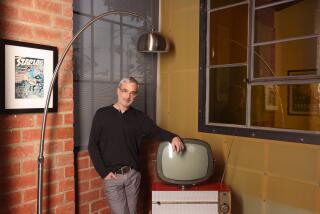Astral Weeks: Why worry? It’s all taken care of in the future
It’s Wednesday morning, oops, afternoon, and the deadline for this month’s column is sort of breathing down my neck, but I’m actually not that worried about writing this review of Charles Yu’s time-travel novel, “How to Live Safely in a Science Fictional Universe” (Pantheon: 240 pp., $24), because reading the book has made me understand that my review already exists in the future. It’s really not a problem!
I just need to get the future Ed Park (the impossibly relaxed one, the one who’s completed the punishing labor of writing this column and is enjoying his traditional celebratory beverage) to step out of one of Yu’s weirdly convincing time machines and hand the piece to me.
Or maybe he can just e-mail it. Because one thing I have to be careful not to do is panic at the sight of my future self and shoot him in the stomach, which is what Yu’s narrator does to his future self. Yu is appropriately perplexed:
Apparently, I’m going to write this book, which appears to be, as far as I can tell, part engineering field manual and part autobiography. Or rather, I already wrote it. Now I just have to write it, which is to say, I have to get to the point in time when I will have written it, and then travel back in time to get shot and then give it to myself, so I can write it. Which all makes sense to me, except for one thing: why the hell would I want to do any of that?
Yu’s narrator, also named Charles Yu — about which, more later — is a shlubby time-machine repairman, a contractor for “ Time Warner Time, which owns and operates this universe as a spatio-temporal structure and entertainment complex zoned for retail, commercial and residential use.” After 10 years on the job, zipping around Minor Universe-31 (a complicated amalgam of New York, Los Angeles and Tokyo), his closest relationships are with TAMMY and Phil, both of whom are computer programs related to his job. (“Phil is an old copy of Microsoft Middle Manager 3.0. His passive-aggressive is set to low. Whoever configured him did me a solid.”)
Yu has a crisp, intermittently lyrical prose style, one that’s comfortable with both math and sadness, moving seamlessly from delirious metafiction (“I’m in the self-consciousness industry”) to the straight-faced prose of instruction-manual entries. (There’s a slight whiff of fanboy in the early innings, with overt references to, or rather intersections with, the Star Wars universe, but it dissipates soon enough.) It’s one of those books that I keep wanting to “tweet,” except my present self has forbidden me from going online until I’ve done my work.
My present self needs to stop being so uptight. It needs to be reminded that my future self has already written the column. It’s in the bag.
Yu — the Yu in the book, now — is the only son of a marriage gone sour. His mother resides in a programmed one-hour loop, a hologram-enhanced slice of her life that poignantly re-creates one of the all-too-rare family dinners that were actually happy. Yu’s father is, or was, a would-be chronodiegetic pioneer whose ambition to build a time-machine ended in tears, a prelude to his disappearing from their lives. Yu’s fate is to try to understand this absence.
The Charles Yu of the future, the one who gets shot, is the author of a book, which the present Charles finds inside the machine, a book called…you guessed it: “How to Live Safely in a Science Fictional Universe.” (As the future Yu crumples from the gunshot, he says to his precursor, “It’s all in the book. The book is the key.”)
A word here about the book within the book, the book that is also, by means of a hilarious contortion, the book we’ve been reading. It’s like Steve Jobs’ ultimate hardware fetish, a dreamlike amalgam of functionality and predetermination. While Yu reads the text, he’s also modifying the text to fit as closely as possible the “actual throughput of my conscious act of reading it … my reading is a creative act.” It’s fun to read Yu dilate on this impossible object:
I’m typing, even though strictly speaking I am using the TM-31’s cognitive-visual-motor-sound-activated recording module, which operates, as you might guess, by simultaneously tracking output from the user’s neural muscle contractions. It’s part keyboard, part microphone, part optical scan, and part brain scan.
Thus he can write by typing, dictation or simply reading and can “switch back and forth among these three modes.” The kicker to such elaborately worked-out mechanics, of course, is that the text is completely static: It’s the book we’re holding, words fixed to the page. (I imagine that those reading “How to Live Safely” on an electronic device would experience an added frisson, thanks to the immateriality of the words — indeed, Yu’s so canny that I bet he thought of this too.)
At times, “How to Live Safely” is like watching an animated version of that Escher print of hands drawing each other. But it’s far from a sterile exercise in closed-system aesthetics, thanks not only to Yu’s sense of humor but also the patient tracking of the ghost in the (time) machine. Ostensibly this is the character of the sad-sack father, who “sometimes said that his life was two-thirds disappointment. This was when he was in a good mood.” The book’s time-travel conceit works so well in part because the family in question is an immigrant family: a family that’s traveled through space. As noted earlier, Yu’s narrator is also named Charles Yu. This information comes before the story begins, but Yu — our real-world author — doesn’t harp on the self-identification, perhaps to the point of coyness. The next time we see the name “Charles Yu” isn’t until Page 91, and it’s tucked away in a schematic to boot (“Partial Map of CY’s Time Loop”).
This has a haunting effect, making ethnicity both there and not there, omnipresent yet muted. The mother is a Buddhist “who used to believe that through meditation it is possible to escape the temporal prison of myopic self-consciousness”; she and her husband “had originally come from a faraway country, a part of reality, a tiny island in the ocean, a different part of the planet, really, a different time, where people still farmed with water buffalo and believed that stories, like life, were all straight lines of chronology.” These descriptions fit a first-generation Asian-American family, yet are deliberately fuzzy; the island (Taiwan) isn’t even named.
Stripped of its SF trappings, the emotional core of the novel is about a family trying to make its way in a new country, trying and failing to fit into its culture and learn its strange tongue. What Yu does is take this familiar story (too familiar, perhaps) and, in the guise of science fiction, make it potent again.
He does this by explicitly connecting time travel with language. “[I]t is possible, in principle, to construct a universal time machine from no other components than (i) a piece of paper that is moved in two directions through a recording element, backward and forward, which (ii) performs only two basic operations, narration and the straightforward application of the past tense.” The “base model” time machine “runs on state-of-the-art chronodiegetical technology: a six-cylinder grammar drive built on a quad-core physics engine, which features an applied temporalinguistics architecture allowing for free-form navigation within a rendered environment, such as, for instance, a story space and, in particular, a science fictional universe.” This is a conception of time travel in which language is more important than physics.
It’s also a metaphor for what gets lost when an old language is shed. Yu’s mother, also “from that little island in reality,” teaches him grammar. She speaks English “well enough,” though “[t]he tenses are so complicated, had never quite made sense to her, as they didn’t work the same way in her language, one based largely on the infinitive.” Her stateside misery might be rooted in an inability to grasp in full the new grammar of their surroundings — an inability to tell their own stories.
It’s no coincidence that Yu’s mom is a Buddhist. A science fictional universe, in which time travel is possible, will be a Buddhist one, an endless viewing loop of primal scenes and blissful moments, as compulsively rereadable as a book — as a book called “How to Live Safely in a Science Fictional Universe.”
Park is a founding editor of The Believer and the author of the novel “Personal Days.” Astral Weeks appears at http://161.35.110.226/books.
More to Read
Sign up for our Book Club newsletter
Get the latest news, events and more from the Los Angeles Times Book Club, and help us get L.A. reading and talking.
You may occasionally receive promotional content from the Los Angeles Times.







